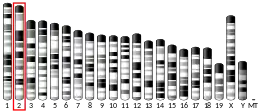Enkurin
Enkurin is a protein that in humans is encoded by the ENKUR gene.[4][5]
| ENKUR | |||||||||||||||||||||||||||||||||||||||||||||||||||
|---|---|---|---|---|---|---|---|---|---|---|---|---|---|---|---|---|---|---|---|---|---|---|---|---|---|---|---|---|---|---|---|---|---|---|---|---|---|---|---|---|---|---|---|---|---|---|---|---|---|---|---|
| Identifiers | |||||||||||||||||||||||||||||||||||||||||||||||||||
| Aliases | ENKUR, C10orf63, CFAP106, enkurin, TRPC channel interacting protein | ||||||||||||||||||||||||||||||||||||||||||||||||||
| External IDs | OMIM: 611025 MGI: 1918483 HomoloGene: 17022 GeneCards: ENKUR | ||||||||||||||||||||||||||||||||||||||||||||||||||
| |||||||||||||||||||||||||||||||||||||||||||||||||||
| |||||||||||||||||||||||||||||||||||||||||||||||||||
| |||||||||||||||||||||||||||||||||||||||||||||||||||
| Wikidata | |||||||||||||||||||||||||||||||||||||||||||||||||||
| |||||||||||||||||||||||||||||||||||||||||||||||||||
Enkurin interacts with transient receptor potential canonical (TRPC) cation channels (e.g., TRPC1) and functions as an adaptor protein, tethering signal transduction proteins to TRPC channels.[5]
References
- GRCm38: Ensembl release 89: ENSMUSG00000026679 - Ensembl, May 2017
- "Human PubMed Reference:". National Center for Biotechnology Information, U.S. National Library of Medicine.
- "Mouse PubMed Reference:". National Center for Biotechnology Information, U.S. National Library of Medicine.
- "Entrez Gene: enkurin".
- Sutton KA, Jungnickel MK, Wang Y, Cullen K, Lambert S, Florman HM (October 2004). "Enkurin is a novel calmodulin and TRPC channel binding protein in sperm". Dev. Biol. 274 (2): 426–35. doi:10.1016/j.ydbio.2004.07.031. PMID 15385169.
Further reading
- Beech DJ (2007). "Canonical transient receptor potential". Transient Receptor Potential (TRP) Channels. Handbook of Experimental Pharmacology. Vol. 179. pp. 109–23. doi:10.1007/978-3-540-34891-7_6. ISBN 978-3-540-34889-4. PMID 17217053.
- Strausberg RL, Feingold EA, Grouse LH, et al. (2002). "Generation and initial analysis of more than 15,000 full-length human and mouse cDNA sequences". Proc. Natl. Acad. Sci. U.S.A. 99 (26): 16899–903. Bibcode:2002PNAS...9916899M. doi:10.1073/pnas.242603899. PMC 139241. PMID 12477932.
- Deloukas P, Earthrowl ME, Grafham DV, et al. (2004). "The DNA sequence and comparative analysis of human chromosome 10". Nature. 429 (6990): 375–81. Bibcode:2004Natur.429..375D. doi:10.1038/nature02462. PMID 15164054.
- Gerhard DS, Wagner L, Feingold EA, et al. (2004). "The status, quality, and expansion of the NIH full-length cDNA project: the Mammalian Gene Collection (MGC)". Genome Res. 14 (10B): 2121–7. doi:10.1101/gr.2596504. PMC 528928. PMID 15489334.
- Ota T, Suzuki Y, Nishikawa T, et al. (2004). "Complete sequencing and characterization of 21,243 full-length human cDNAs". Nat. Genet. 36 (1): 40–5. doi:10.1038/ng1285. PMID 14702039.
This article is issued from Wikipedia. The text is licensed under Creative Commons - Attribution - Sharealike. Additional terms may apply for the media files.

